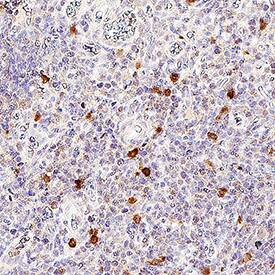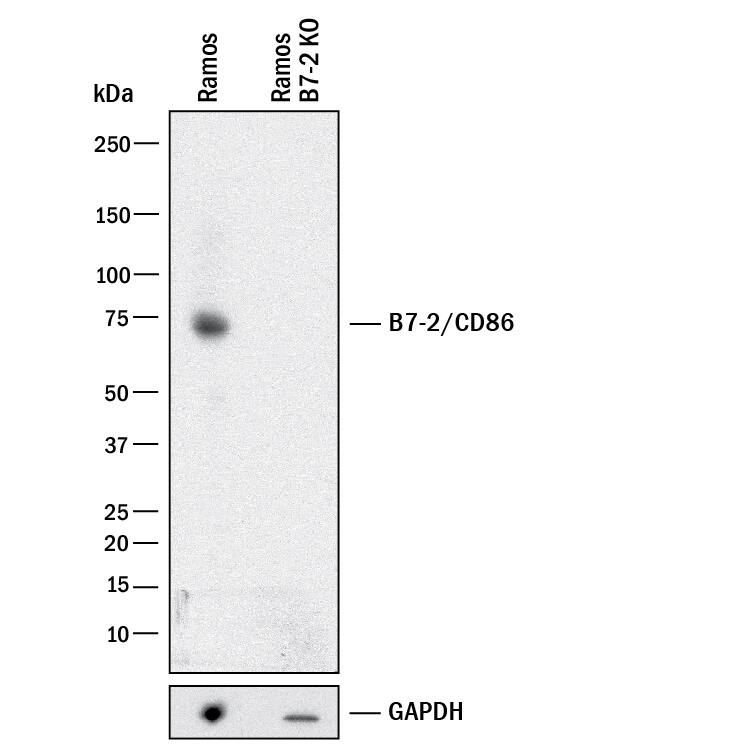Cynomolgus Monkey B7-2/CD86 Antibody
R&D Systems, part of Bio-Techne | Catalog # MAB10601

Key Product Details
Species Reactivity
Cynomolgus Monkey
Applications
Immunohistochemistry, Knockout Validated, Western Blot
Label
Unconjugated
Antibody Source
Monoclonal Mouse IgG1 Clone # 1029808
Product Specifications
Immunogen
Human embryonic kidney cell HEK293-derived cynomolgus monkey B7-2/CD86 protein
Leu20-His239
Accession # XP_005548057
Leu20-His239
Accession # XP_005548057
Specificity
Detects cynomolgus monkey B7-2/CD86 in direct ELISAs.
Clonality
Monoclonal
Host
Mouse
Isotype
IgG1
Scientific Data Images for Cynomolgus Monkey B7-2/CD86 Antibody
Western Blot Shows Human B7-2/CD86 Specificity by Using Knockout Cell Line.
Western blot shows lysates of Ramos human Burkitt's lymphoma cell line and human B7-2/CD86 knockout Ramos cell line (KO). PVDF membrane was probed with 2 µg/mL of Mouse Anti-Cynomolgus Monkey B7-2/CD86 Monoclonal Antibody (Catalog # MAB10601) followed by HRP-conjugated Anti-Mouse IgG Secondary Antibody (HAF018). A specific band was detected for B7-2/CD86 at approximately 70 kDa (as indicated) in the parental cell line, but is not detectable in knockout cell line. GAPDH (Catalog # MAB5718) is shown as a loading control. This experiment was conducted under reducing conditions and using Western Blot Buffer Group 1.Detection of Human B7-2/CD86 by Western Blot.
Western blot shows lysates of HDLM-2 human Hodgkin’s lymphoma cell line. PVDF membrane was probed with 2 µg/mL of Mouse Anti-Cynomolgus Monkey B7-2/CD86 Monoclonal Antibody (Catalog # MAB10601) followed by HRP-conjugated Anti-Mouse IgG Secondary Antibody (HAF018). A specific band was detected for B7-2/CD86 at approximately 70 kDa (as indicated). This experiment was conducted under reducing conditions and using Western Blot Buffer Group 1.B7-2/CD86 in Human Tonsil.
B7-2/CD86 was detected in immersion fixed paraffin-embedded sections of human tonsil using Mouse Anti-Cynomolgus Monkey B7-2/CD86 Monoclonal Antibody (Catalog # MAB10601) at 15 µg/mL for 1 hour at room temperature followed by incubation with the Anti-Mouse IgG VisUCyte™ HRP Polymer Antibody (VC001). Before incubation with the primary antibody, tissue was subjected to heat-induced epitope retrieval using Antigen Retrieval Reagent-Basic (CTS013). Tissue was stained using DAB (brown) and counterstained with hematoxylin (blue). Specific staining was localized to cytoplasm in lymphocytes. Staining was performed using our protocol for IHC Staining with VisUCyte HRP Polymer Detection Reagents.Applications for Cynomolgus Monkey B7-2/CD86 Antibody
Application
Recommended Usage
Immunohistochemistry
8-25 µg/mL
Sample: Immersion fixed paraffin-embedded sections of human tonsil
Sample: Immersion fixed paraffin-embedded sections of human tonsil
Knockout Validated
2 µg/mL
Sample: B7‑2/CD86 is specifically detected in Ramos parental cell line but is not detectable in B7‑2/CD86 knockout Ramos cell line.
Sample: B7‑2/CD86 is specifically detected in Ramos parental cell line but is not detectable in B7‑2/CD86 knockout Ramos cell line.
Western Blot
2 µg/mL
Sample: HDLM‑2 human Hodgkin's lymphoma cell line
Sample: HDLM‑2 human Hodgkin's lymphoma cell line
Formulation, Preparation, and Storage
Purification
Protein A or G purified from hybridoma culture supernatant
Reconstitution
Reconstitute at 0.5 mg/mL in sterile PBS. For liquid material, refer to CoA for concentration.
Formulation
Lyophilized from a 0.2 μm filtered solution in PBS with Trehalose. *Small pack size (SP) is supplied either lyophilized or as a 0.2 µm filtered solution in PBS.
Shipping
Lyophilized product is shipped at ambient temperature. Liquid small pack size (-SP) is shipped with polar packs. Upon receipt, store immediately at the temperature recommended below.
Stability & Storage
Use a manual defrost freezer and avoid repeated freeze-thaw cycles.
- 12 months from date of receipt, -20 to -70 °C as supplied.
- 1 month, 2 to 8 °C under sterile conditions after reconstitution.
- 6 months, -20 to -70 °C under sterile conditions after reconstitution.
Background: B7-2/CD86
References
- Greenwald, R.J. et al. (2005) Annu. Rev. Immunol. 23:515.
- Bour-Jordan, H. et al. (2011) Immunol. Rev. 241:180.
- Freeman, G.J. et al. (1993) J. Exp. Med. 178:2185.
- Lenschow, D.J. et al. (1993) Proc. Natl. Acad. Sci. USA 90:11054.
- Hathcock, K.S. et al. (1993) Science 262:905.
- Seino, K. et al. (1995) Int. Immunol.7:1331.
- Chen, C. et al. (1994) J. Immunol. 152:4929.
- Lanier, L.L. et al. (1995) J. Immunol. 154:97.
- Rudd, C.E. et al. (2009) Immunol. Rev. 229:12.
- Wing, K. et al. (2011) Trends Immunol. 32:428.
- Pentcheva-Hoang, T. et al. (2004) Immunity 21:401.
- Kuchroo, V.K. et al. (1995) Cell 80:707.
- Short, J.J. et al. (2006) Virus Res. 122:144.
Alternate Names
B72, CD86
Gene Symbol
CD86
UniProt
Additional B7-2/CD86 Products
Product Documents for Cynomolgus Monkey B7-2/CD86 Antibody
Product Specific Notices for Cynomolgus Monkey B7-2/CD86 Antibody
For research use only
